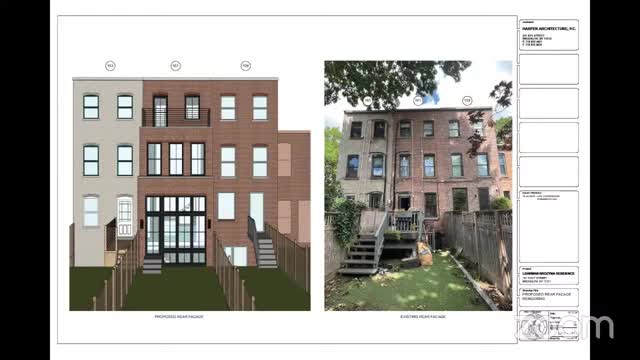Community Board rejects controversial Brooklyn home addition
October 22, 2024 | Land Preservation Commission, New York City Board & Committees, New York City, New York County, New York
This article was created by AI summarizing key points discussed. AI makes mistakes, so for full details and context, please refer to the video of the full meeting. Please report any errors so we can fix them. Report an error »

In a recent meeting of the Brooklyn Community Board 2, significant discussions emerged regarding a proposed addition to a row house on Hoyt Street, which has sparked considerable local opposition. The board expressed concerns about the scale and design of the addition, recommending conditional disapproval. Members highlighted the need for the proposal to either reduce its bulk to a single two-story structure with a basement or simplify its design to better align with the historic character of the surrounding buildings.
The committee noted that the addition's placement amid three identically sized historic structures raised questions about its appropriateness. Local residents had previously submitted written opposition and attended the meeting to voice their concerns, emphasizing the importance of maintaining the neighborhood's aesthetic integrity.
The board's discussions included a recommendation for formal mediation between the applicants and their neighbors to address aesthetic differences. Additionally, there were calls for reimagining the materials used in the addition to lessen its visual impact.
The applicant defended the proposal, asserting that it complied with the Landmarks Preservation Commission (LPC) guidelines and was consistent with other approved additions in the area. They emphasized their efforts to engage with neighbors and modify the design in response to feedback, including a reduction in the size of the addition.
The LPC's review process was also discussed, particularly the application of the \"50% rule,\" which governs the approval of rear yard additions based on the context of existing structures. The applicant argued that their design was comparable to other recent approvals in Brooklyn, suggesting that the commission should evaluate the project on its merits.
As the meeting concluded, commissioners expressed mixed feelings about the proposal, with some indicating that the addition could be appropriate given the context. The board's decision remains pending as they continue to weigh the community's concerns against the applicant's arguments for the addition.
The committee noted that the addition's placement amid three identically sized historic structures raised questions about its appropriateness. Local residents had previously submitted written opposition and attended the meeting to voice their concerns, emphasizing the importance of maintaining the neighborhood's aesthetic integrity.
The board's discussions included a recommendation for formal mediation between the applicants and their neighbors to address aesthetic differences. Additionally, there were calls for reimagining the materials used in the addition to lessen its visual impact.
The applicant defended the proposal, asserting that it complied with the Landmarks Preservation Commission (LPC) guidelines and was consistent with other approved additions in the area. They emphasized their efforts to engage with neighbors and modify the design in response to feedback, including a reduction in the size of the addition.
The LPC's review process was also discussed, particularly the application of the \"50% rule,\" which governs the approval of rear yard additions based on the context of existing structures. The applicant argued that their design was comparable to other recent approvals in Brooklyn, suggesting that the commission should evaluate the project on its merits.
As the meeting concluded, commissioners expressed mixed feelings about the proposal, with some indicating that the addition could be appropriate given the context. The board's decision remains pending as they continue to weigh the community's concerns against the applicant's arguments for the addition.
View full meeting
This article is based on a recent meeting—watch the full video and explore the complete transcript for deeper insights into the discussion.
View full meeting
